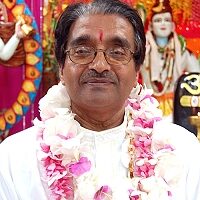From a satsang with Pt. Dr. Umesh Persad, Spiritual Leader, Shiva Shakti Mandir of Marion Oaks, Florida
Auspicious occasions like Krishna Janmashtami hold a profound significance, offering us opportunities to connect with the divinity within ourselves. These celebrations are not just rituals; they are moments to reflect on divine principles and apply them to our own lives.
In the Shrimad Bhagwat Maha Puraan, the story of Lord Krishna’s birth carries deep symbolic meanings. Understanding the Sanskrit names and familial relationships within this katha provides insights into solving life’s challenges. Our method combines gyaan bhakti—devotion infused with knowledge—emphasising that wisdom (gyaan) and knowledge (vidya) are intertwined. Paravidya involves extracting principles from knowledge to gain deeper insights while gyaan is the experiential truth.
The roots of Sanskrit words are rich with meaning. For instance, King Kansa represents desire, particularly the longing for worldly pleasures. These desires, whether for resources or relationships, are fleeting and often bring worry. We worry about losing what we have and about not having what we desire. Thus, Kansa symbolises the desires that reside deep within all our minds.
Kansa’s sister, Devaki, represents good qualities, and her husband, Vasudeva, symbolises awareness (the waters or ocean in Sanaatan Dharma). Together, they embody the cultivation of virtues such as kindness and compassion within us. The union of Devaki and Vasudeva signifies our efforts to develop these good qualities, which are constantly threatened by the desires personified by Kansa.
Devaki and Vasudeva’s children symbolise the growth of virtues within us. Their six sons represent Shat Sampath—the six forms of spiritual wealth:
- Shama: tranquillity of mind
- Dama: control of the senses
- Uparati: the ability to withdraw from distractions
- Titiksha: endurance and tolerance
- Samadhan: inward contentment
- Shraddha: faith or awareness of the true self
However, our desires (Kansa) can disrupt this development, hindering our spiritual growth.
Balram, their seventh child, signifies inner strength and willpower, born of Rohini, representing the senses. When we harness our willpower to control our senses, we pave the way for the birth of Shree Krishna, the eighth child. Shree Krishna, whose name means “dark” and “blissful”, represents the Supreme Spirit, our true essence. Though Shree Krishna had to leave his birth parents, symbolising that our experience of divine joy is often fleeting, he traversed the Yamuna River, signifying the duality within us—the true self and the false ego.
Shree Krishna’s journey across the Yamuna with Vasudeva teaches us to recognize our true self (the atma) and the false self (the ego or ahamkara). To destroy the ego and realise our true nature, we must identify with the atma. Shree Krishna, nurtured by Nanda and Yashoda, symbolises bliss and splendour.
The katha of Krishna Janmashtami guides us towards self-realisation, emphasising that Shree Krishna is our true nature, residing within us. The journey is about becoming aware of this inner divinity. By reflecting on what we seek and turning our vision inward, we can nurture our virtues, control our mind and senses, and keep desires in check. Recognising that we are not our mind but the divine essence within, we can then transcend the fear of death.
This celebration encourages us to look within, develop our good qualities and strive for self-realisation, ultimately experiencing the divinity of Shree Krishna within ourselves.



